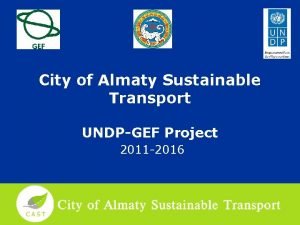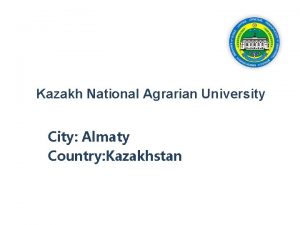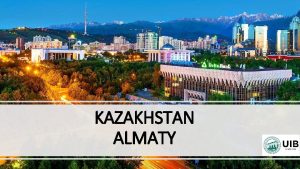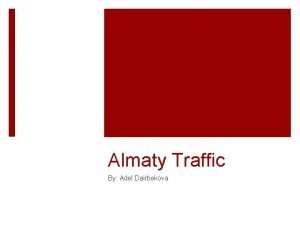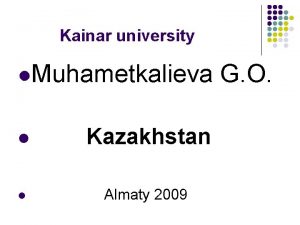Kazakh National Agrarian University City Almaty Country Kazakhstan
















- Slides: 16

Kazakh National Agrarian University City: Almaty Country: Kazakhstan

Agenda 1. 2. 3. 4. 5. 6. 7. Credit system used at the institution Alignment (or lack of) with the Bologna Process Use (or lack of) ECTS Administration structure supporting student mobility Student mobility process Credit transfer process Grade conversion process

Credit system at the Kazakh National Agrarian University • The implementing of credit system takes its root from the mid 1990 th in Kazakhstan. Kazakh National Agrarian University (Kaz. NAU) is one of the first universities in Kazakhstan which implemented the credit system of education. • There are 3 cycles of training: • Bachelor’s (4 years) • Master’s (2 years) • Ph. D Doctoral (3 years)

Alignment (or lack of) with the Bologna Process Kaz. NAU joined the Great Charter of Universities on September 18, 2009 in support of the basic principles of the Bologna Process: - three leveled training (Bachelor’s, Master’s and Ph. D doctoral degree) - realizing students and staff exchange programs - academic mobility - internal academic mobility - credit system of education - cooperation with 130 foreign universities and scientific research institutes and centres in the field of education, science, industry in order to integrate education, science and industry - establishing scientific training research centres with the participation of international experts

Finland German y Switzerla nd Bulgaria Hungary Malaysi a Belgium Spain USA Kazakh National Agrarian University Slovakia France Czech Republi c South Korea Italy Slovenia Canada Poland Serbia Latvia China Etc…. .

Use (or lack of) ECTS • • To ensure the academic mobility of students and the recognition of educational programmes (all levels and forms of higher and postgraduate education) in the European educational space, it is necessary to transfer Kazakhstan credits to ECTS credits and conversely. Recalculation of ECTS credits into Kazakhstani credits system is carried out on the basis of transferable coefficients. Academic credit in the framework of ECTS is a unit of measurement of the complexity of studying the discipline both in classroom activities (lectures, seminars, laboratory classes and others) and during the independent work writing essay, practical training and internships and etc. ) of a student. Transfer of credits ECTS to credits of the Republic of Kazakhstan is carried out by dividing the ECTS credits in the conversion factor depending on density 1 ECTS credit for each discipline in the range of 1. 5 to 1. 8

Academic mobility regulation An educational process by credit system of academic mobility regulated by the following documents: The Law on Education and Science of the Republic of Kazakhstan The Programme of Education and Development for 2011 -2020 The Rules on Organization of Educational Process on Credit Technology The Concept of Academic Mobility for Students of HEI Regulations for Studying Abroad including Academic Mobility

Administration structure supporting student mobility Department of Academic Mobility and International Educational Programs Department of Office Registrar Department for Academic Affairs Student mobility 6 Faculty Coordinators and Departments International Cooperation Department Linguistic Centre

Student mobility process Before mobility Planning * Call for students *Selecting students, programs *Agreeing with Partner Universities *Comparing training programs *Solving money issues *Collecting documents After mobility Credit recognition

Student mobility process • When planning and organizing academic mobility in Kazakhstan universities, the following normative documents are used: • Information package; • Application of a student going for the mobility programmes; • Agreement on training in mobility programmes; • Transcript on training.

Credit transfer process Comparison and credit transfer order of Kazakhstani credits and ECTS for Bachelor degree Parameters ECTS Kazakhstan credit system Total number of credit for academic years 180 credits for 3 years, 240 credits for 4 years 129 credits for theoretical training, total 146 credits for 4 years Per academic year 60 credits 24 -36 credits 1 credit 25 -30 hours 45 hours – theoretical training 15 hours – practical training 30 hours – pedagogical practice 75 hours – professional practice

Credit transfer process • For Master’s degree – 42 credits for theoretical training and 59 in total • Ph. D Degree – 36 credits for theoretical training and 75 credits in total

Credit transfer process Types of academic work Meaning of coefficients min max Theoretical training (including classroom and independent work) 1, 5 1, 8 Academic practice 0, 5 0, 6 Pedagogical practice 1, 0 1, 2 Industrial practice 2, 5 3, 0 Total attestation 3, 2 4, 5

Grade conversion process • • All HEI of the Republic of Kazakhstan implement a rating-based alphabetical system for evaluating students' learning achievements, which include ten evaluation clauses (from "A" to "D") with a digital equivalent (from 1. 00 to 4. 00 points), which provide credits and one unsatisfactory evaluation (“F") without providing credits The rating scale ECTS includes five positive ratings (from "A" to "E"), an estimate of “FX" which can be corrected and assessed “F" without gaining credits

Grade conversion process • Grade conversion of ECTS into a rating-letter system for assessing the learning achievements of students can be seen in the following table: Letter version Number version % ECTS Traditional A 4, 0 95 -100 A “Excellent” A- 3, 67 90 -94 B+ 3, 33 85 -89 B “Good” B 3, 0 80 -84 C B- 2, 67 75 -79 C+ 2, 33 70 -74 C 2, 0 65 -69 C- 1, 67 60 -64 D+ 1, 33 55 -59 D 1, 0 50 -54 E F 0 0 -49 FX, F “Satisfactory” D “Unsatisfactory”

Thank you for your attention!
 Bila tserkva national agrarian university
Bila tserkva national agrarian university Kazakh university of technology and business
Kazakh university of technology and business казанский аграрный университет
казанский аграрный университет Carsharing almaty
Carsharing almaty Katelco
Katelco Almaty population
Almaty population Adopted bayan-anihan
Adopted bayan-anihan Alauddin khilji agrarian reform
Alauddin khilji agrarian reform Joseph boyce agrarian revolution
Joseph boyce agrarian revolution Urban agrarian
Urban agrarian Ndc kazakhstan
Ndc kazakhstan Ijara company
Ijara company Sherkala and kok tobe are
Sherkala and kok tobe are Inflation rate kazakhstan
Inflation rate kazakhstan Education system in kazakhstan presentation
Education system in kazakhstan presentation Kazakhstan government type
Kazakhstan government type Dqa standards
Dqa standards





